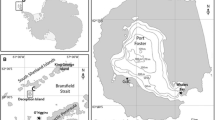Abstract
Variations in the antibacterial activity of the sponge Ircinia ramosa were evaluated during two collection periods (January and May) against vicinity fouling bacteria (VFB) and sponge surface-associated bacteria (SAB). The density of fouling bacteria in the water column, as well as epibacterial abundance on the sponge surface, was enumerated during both collections, and both increased in the warmer month of May. The extracts obtained from SAB were also tested for their role in antibacterial activity of the host. Sponge-associated bacteria are capable of producing antibacterial metabolites. The antibacterial activity that originated from polar fractions in the cooler month of January shifted towards the nonpolar fractions in May. Nonpolar fractions were more useful for the sponge when threatened with increased bacterial density. Thus, the chemical nature and production of antibacterial compounds produced by sponge or its associated bacteria appears to be governed by the environment. An inverse relationship was observed between the epibacterial abundance over the sponge surface in nature and the antibacterial activity displayed by the sponge extracts in laboratory bioassays. This investigation reveals the importance of collection period as well as the role of associated bacteria in the evaluation of antibacterial activity.
Similar content being viewed by others
REFERENCES
Althof,Ñ K.,Ñ Shutt,Ñ C.,Ñ Stefen,Ñ R.,Ñ Batel,Ñ R.,ÑandÑ Muller,Ñ W.ÑE.ÑG.Ñ1998.ÑEvidenceÑforÑaÑsymbiosisÑbetweenÑbacteriaÑofÑtheÑgenusÑRhodobacterÑandÑtheÑmarineÑspongeÑHalichondriaÑpanicea:ÑHabourÑalsoÑforÑputativelyÑtoxicÑbacteria?ÑMar.ÑBiol.Ñ130:529–536.
Amade,Ñ P.,Ñ Pesando,Ñ D.,ÑandÑ Chevolot,Ñ L.Ñ1982.ÑAntimicrobialÑactivityÑofÑmarineÑspongeÑfromÑFrenchÑPolynesiaÑandÑBrittany.ÑMar.ÑBiol.Ñ70:223–228.
Bakus,Ñ G.ÑJ.,Ñ Shulte,Ñ B.,Ñ Jhu,Ñ S.,Ñ Wright,Ñ M.,Ñ Green,Ñ G.,ÑandÑ Gomez,Ñ P.Ñ1985.ÑAntibiosisÑandÑantifoulingÑinÑmarineÑsponges:ÑLaboratoryÑversusÑfieldÑstudies.ÑProceedingsÑ3rdÑInternationalÑSpongeÑConference,Ñpp.Ñ102–108.
Bakus,Ñ G.ÑJ.,Ñ Targett,Ñ N.ÑM.,ÑandÑ Schulte,Ñ B.Ñ1986.ÑChemicalÑecologyÑofÑmarineÑorganisms:ÑAnÑoverview.ÑJ.ÑChem.ÑEcol.Ñ12:951–987.
Becerro,Ñ M.ÑA.,Ñ Lopez,Ñ N.ÑI.,Ñ Turon,Ñ X.,ÑandÑ Uriz,Ñ M.ÑJ.Ñ1994.ÑAntimicrobialÑactivityÑandÑsurfaceÑbacterialÑfilmÑinÑmarineÑsponges.ÑJ.ÑExp.ÑMar.ÑBiol.ÑEcol.Ñ179:195–205.
Bergquist,Ñ P.ÑR.,ÑandÑ Bedford,Ñ J.ÑJ.Ñ1978.ÑTheÑincidenceÑofÑantimicrobialÑactivityÑinÑmarineÑDemospongiaeÑsystematicÑandÑgeographicÑconsiderations.ÑMar.ÑBiol.Ñ46:215–221.
Buchanan,Ñ R.ÑE.,ÑandÑ Gibbons,Ñ N.ÑE.Ñ(eds.).Ñ1984.ÑBergeysÑManualÑofÑDeterminativeÑBacteriology,Ñ8thÑed.ÑWilliamsÑandÑWilkins,Ñ Baltimore.
Clare,Ñ A.ÑS.Ñ1996.ÑMarineÑnaturalÑproductÑantifoulants:ÑStatusÑandÑpotential.ÑBiofoulingÑ9:211–229.
Clare,Ñ A.ÑS.,Ñ Rittschof,Ñ D.,Ñ Gerhart,Ñ D.ÑJ.,ÑandÑ Maki,Ñ J.ÑS.Ñ1992.ÑMolecularÑapproachesÑtoÑnontoxicÑantifouling.ÑInvert.ÑProd.ÑDev.Ñ22:67–76.
Davis,Ñ A.ÑR.,Ñ Targett,Ñ N.ÑM.,Ñ McConnell,Ñ O.ÑJ.,ÑandÑ Young,Ñ C.ÑM.Ñ1989.ÑEpibiosisÑofÑmarineÑalgaeÑandÑbenthicÑinvertebrates:ÑNaturalÑproductsÑchemistryÑandÑotherÑmechanismsÑinhibitingÑsettlementÑandÑovergrowth,Ñpp.Ñ85–114,ÑinÑP.ÑJ.Ñ ScheuerÑ(ed.)ÑBioorganicÑMarineÑChemistry,ÑVol.Ñ3.ÑSpringer-Verlag,Ñ Berlin.
Dworjanyn,Ñ S.ÑA.,Ñ DeÑNys,Ñ R.,ÑandÑ Steinberg,Ñ P.ÑD.Ñ1999.ÑLocalisationÑandÑsurfaceÑquantificationÑofÑsecondaryÑmetabolitesÑinÑtheÑredÑalgaÑDeliseaÑpulchra.ÑMar.ÑBiol.Ñ133(4):727–736.
Elyakov,Ñ G.ÑB.,Ñ Stonik,Ñ V.ÑA.,Ñ Kuznetsova,Ñ T.ÑA.,Ñ Mikhailov,Ñ V.ÑV.,ÑetÑal.Ñ1991.ÑBrominatedÑdiphenylÑetherÑfromÑaÑmarineÑbacteriumÑassociatedÑwithÑtheÑspongeÑDysideaÑsp.ÑExperientiaÑ47:632–633.
Elyakov,Ñ G.ÑB.,Ñ Kuznetsova,Ñ T.ÑA.,ÑandÑ Mikhailov,Ñ V.ÑV.Ñ1996.ÑFromÑchemistryÑofÑmarineÑnaturalÑproductsÑtoÑmarineÑtechnologies:ÑResearchÑatÑtheÑPacificÑinstituteÑofÑbioorganicÑchemistry.ÑMar.ÑTech.ÑSoc.ÑJ.Ñ30:21–28.
Fenical,Ñ W.Ñ1993.ÑChemicalÑstudiesÑonÑmarineÑbacteria:ÑDevelopingÑaÑnewÑresource.ÑChem.ÑRev.Ñ93:1673–1683.
Gill-Turnes,Ñ M.ÑS.,ÑandÑ Fenical,Ñ W.Ñ1992.ÑEmbryosÑofÑHomarusÑamericanusÑareÑprotectedÑbyÑepibioticÑbacteria.ÑBiol.ÑBull.ÑMar.ÑBiol.ÑLab.ÑWoodsÑHoleÑ182:105–108.
Green,Ñ G.ÑP.,Ñ Gomez,Ñ P.,ÑandÑ Bakus,Ñ G.ÑJ.Ñ1985.ÑAntimicrobialÑandÑichthyotoxicÑpropertiesÑofÑmarineÑspongesÑfromÑMexicanÑwaters.ÑProceedings,Ñ3rdÑInternational,ÑSpongeÑConference,Ñpp.Ñ109–114.
Kalinovaskaya,Ñ N.ÑI.,Ñ Kuznetsova,Ñ T.ÑA.,Ñ Rashkes,Ñ Ya.ÑW.,ÑetÑal.Ñ1995.ÑTheÑchemicalÑstructuresÑofÑfiveÑsurfactinÑlikeÑdepsipeptidesÑfromÑmarineÑisolateÑBacillusÑpumilus.ÑIzvestiyaÑRAN.Ñ44:951–955Ñ(inÑRussian).
Kon-YaÑ K.,Ñ Shimidzu,Ñ N.,Ñ Otaki,Ñ N.,Ñ Yokoyama,Ñ A.,Ñ Adachi,Ñ K.,ÑandÑ Miki,Ñ W.Ñ1995.ÑInhibitoryÑeffectÑofÑbacterialÑubiquinonesÑonÑtheÑsettlingÑofÑbarnacleÑBalanusÑamphitrite.ÑExperientiaÑ51:153–155.
McCaffrey,Ñ E.ÑJ.,ÑandÑ Enden,Ñ R.Ñ1985.ÑAntimicrobialÑactivityÑofÑtropicalÑandÑsubtropicalÑsponges.ÑMar.ÑBiol.Ñ89:1–8.
Mokashe,Ñ S.ÑS.,Ñ Garg,Ñ A.,Ñ Anil,Ñ A.ÑC.,ÑandÑ Wagh,Ñ A.ÑB.Ñ1994.ÑGrowthÑinhibitionÑofÑperiphyticÑdiatomsÑbyÑmethanolÑextractÑofÑspongeÑandÑholothurians.ÑIndianÑJ.ÑMar.ÑSci.Ñ23:57–58.
Okami,Ñ Y.Ñ1986.ÑMarineÑmicroorganismsÑasÑaÑsourceÑofÑbioactiveÑagents.ÑMicrob.ÑEcol.Ñ12:65–78.
Parulekar,Ñ A.ÑH.,ÑandÑ Shirvoikar,Ñ P.Ñ1991.ÑBioactivityÑandÑchemicalÑecologyÑofÑsomeÑintertidalÑanimals,Ñpp.Ñ29–35,ÑinÑBioactiveÑCompoundsÑfromÑMarineÑOrganisms.ÑM.ÑF.Ñ Thompson,Ñ R.Ñ Sarojani,Ñ R.Ñ NagabhushanamÑ(eds.).ÑOxfordÑ&ÑIBHÑPublishing,Ñ NewÑDelhi.
Paul,Ñ V.ÑJ.Ñ1992.ÑChemicalÑdefenceÑofÑbenthicÑmarineÑinvertebrates,Ñpp.Ñ164–188,ÑinÑV.ÑJ.Ñ Paul,Ñ(ed.).ÑEcologicalÑRolesÑofÑMarineÑNaturalÑProducts.ÑComstock,Ñ Ithaca.
Pawlik,Ñ J.ÑR.Ñ1993.ÑMarineÑinvertebrateÑchemicalÑdefenses.ÑChem.ÑRev.Ñ93:1911–1922.
Ramaiah,Ñ N.,Ñ Raghukumar,Ñ S.,ÑandÑ Gaus,Ñ M.Ñ1996.ÑBacterialÑabundanceÑandÑproductionÑinÑtheÑcentralÑandÑeasternÑArabianÑsea.ÑCurr.ÑSci.Ñ(specialÑsection:ÑJGOFS,Ñ India)Ñ71:878–882.
Schmitt,Ñ T.ÑM.,Ñ Hay,Ñ M.ÑE.,ÑandÑ Lindquist,Ñ N.Ñ1995.ÑConstraintsÑonÑchemicallyÑmediatedÑcoevolutionÑmultipleÑfunctionÑforÑseaweedÑsecondaryÑmetabolites.ÑEcologyÑ76:107–123.
Slattery,Ñ M.,Ñ McClintock,Ñ J.ÑB.,ÑandÑ Heine,Ñ J.ÑN.Ñ1995.ÑChemicalÑdefencesÑinÑAntarcticÑsoftÑcorals:ÑEvidenceÑforÑantifoulingÑcompounds.ÑJ.ÑExp.ÑMar.ÑBiol.ÑEcol.Ñ190:61–77.
Sokal,Ñ R.ÑR.,ÑandÑ Rohlf,Ñ F.ÑJ.Ñ1981.ÑBiometry:ÑTheÑPrinciplesÑandÑPracticeÑofÑStatisticsÑinÑBiologicalÑResearch.ÑW.ÑH.ÑFreeman,Ñ SanÑFrancisco.
Steinberg,Ñ P.ÑD.,Ñ DeÑNys,Ñ R.,ÑandÑ Kjelleberg,Ñ S.Ñ1998.ÑChemicalÑinhibitionÑbyÑepibiotaÑbyÑAustralianÑseaweeds.ÑBiofoulingÑ12:227–244.
Stierle,Ñ A.ÑC.,Ñ Cardellina,Ñ J.ÑH.,ÑII,ÑandÑ Singleton,Ñ F.ÑL.Ñ1988.ÑMarineÑMicrococcusÑproducesÑmetabolitesÑascribedÑtoÑtheÑspongeÑTedaniaÑignis.ÑExperientiaÑ44:1021.
Thompson,Ñ J.ÑE.,Ñ Walker,Ñ R.ÑP.,ÑandÑ Faulkner,Ñ D.ÑJ.Ñ1985.ÑScreeningÑandÑbioassaysÑforÑbiologicallyÑactiveÑsubstancesÑfromÑfortyÑmarineÑspongesÑfromÑSanÑDiego,ÑCalifornia,ÑUSA.ÑMar.ÑBiol.Ñ88:11–21.
Unabia,Ñ C.ÑR.ÑC.,Ñ Hagdone,Ñ M.ÑR.,Ñ Hadfield,Ñ M.ÑG.,Ñ Gu,Ñ X.-Q.,Ñ Lau,Ñ L.,ÑandÑ Tius,Ñ M.ÑA.Ñ1997.ÑBioactiveÑmarineÑisonitrileÑcompoundsÑfromÑHawaiianÑspongeÑasÑmodelÑforÑsyntheticÑnontoxicÑantifoulantÑandÑantibioticÑagents,ÑInÑProceedingÑofÑUS-PacificÑRimÑWorkshopÑHawaiiÑU.S.A.Ñ(MarchÑ17–20,Ñ1997),ÑEmergingÑNon-MetallicÑMaterialsÑforÑtheÑMarineÑEnvironment,ÑSectionÑ3:30–36.
Unison,Ñ M.ÑD.,Ñ Holland,Ñ N.ÑD.,ÑandÑ Faulkner,Ñ D.ÑJ.Ñ1994.ÑAÑbrominatedÑsecondaryÑmetabolite,ÑsynthesizedÑbyÑtheÑcyanobacterialÑsymbiontÑofÑaÑmarineÑspongeÑandÑaccumulationÑofÑtheÑcrystallineÑmetaboliteÑinÑtheÑspongeÑtissue.ÑMar.ÑBiol.Ñ119:1–11.
Vacelet,Ñ J.,ÑandÑ Donadey,Ñ C.Ñ1977.ÑElectronÑmicroscopyÑstudyÑofÑtheÑassociationÑbetweenÑsomeÑspongesÑandÑbacteria.ÑJ.ÑExp.ÑMar.ÑBiol.ÑEcol.Ñ30:301–314.
Wahl,Ñ M.,Ñ Jensen,Ñ P.ÑR.,ÑandÑ Fenical,Ñ W.Ñ1994.ÑChemicalÑcontrolÑofÑbacterialÑepibiosisÑonÑascidians.ÑMar.ÑEcol.ÑProg.ÑSer.Ñ110:45–57.
Walker,Ñ R.ÑP.,Ñ Thompson,Ñ J.ÑE.,ÑandÑ Faulkner,Ñ D.ÑJ.Ñ1985.ÑExudationÑofÑbiologicallyÑactiveÑmetabolitesÑinÑtheÑspongeÑAplysiniaÑfistularis.ÑMar.ÑBiol.Ñ88:27–32.
Walls,Ñ J.ÑT.,Ñ Ritz,Ñ D.ÑA.,ÑandÑ Blackman,Ñ A.ÑJ.Ñ1993.ÑFouling,ÑsurfaceÑbacteriaÑandÑantibacterialÑagentsÑofÑfourÑbryozoanÑspeciesÑfoundÑinÑTasmania,ÑAustralia.ÑJ.ÑExp.ÑMar.ÑBiol.ÑEcol.Ñ169:1–13.
Wilkinson,Ñ C.ÑR.Ñ1987.ÑSignificanceÑofÑmicrobialÑsymbiontsÑinÑspongeÑevolutionaryÑecology.ÑSymbiosisÑ4:135–146.
Rights and permissions
About this article
Cite this article
Thakur, N.L., Anil, A.C. Antibacterial Activity of the Sponge Ircinia Ramosa: Importance of its Surface-Associated Bacteria. J Chem Ecol 26, 57–71 (2000). https://doi.org/10.1023/A:1005485310488
Issue Date:
DOI: https://doi.org/10.1023/A:1005485310488




